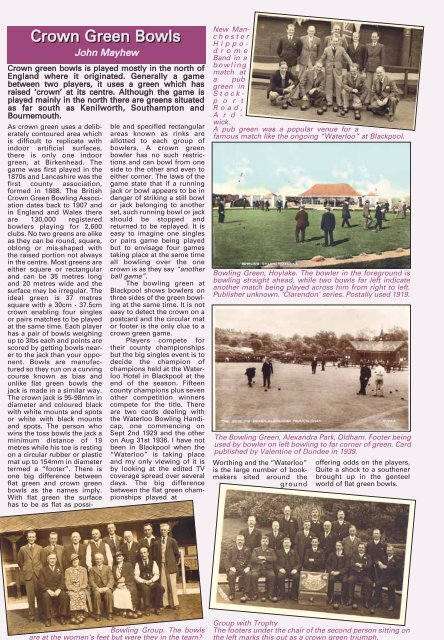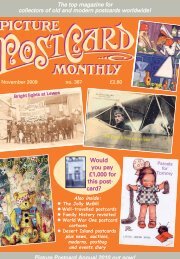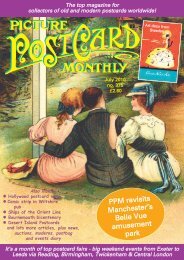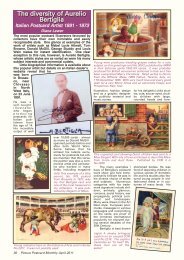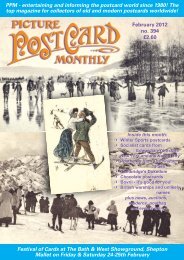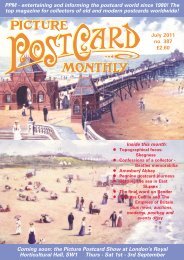Christmas special: Postcard Stockings galore! - Picture Postcard ...
Christmas special: Postcard Stockings galore! - Picture Postcard ...
Christmas special: Postcard Stockings galore! - Picture Postcard ...
You also want an ePaper? Increase the reach of your titles
YUMPU automatically turns print PDFs into web optimized ePapers that Google loves.
Crown Green Bowls<br />
John MMayhew<br />
Crown green bowls is played mostly in the north of<br />
England where it originated. Generally a game<br />
between two players, it uses a green which has<br />
raised ‘crown’ at its centre. Although the game is<br />
played mainly in the north there are greens situated<br />
as far south as Kenilworth, Southampton and<br />
Bournemouth.<br />
As crown green uses a deliberately<br />
contoured area which<br />
is difficult to replicate with<br />
indoor artificial surfaces,<br />
there is only one indoor<br />
green, at Birkenhead. The<br />
game was first played in the<br />
1870s and Lancashire was the<br />
first county association,<br />
formed in 1888. The British<br />
Crown Green Bowling Association<br />
dates back to 1907 and<br />
in England and Wales there<br />
are 130,000 registered<br />
bowlers playing for 2,600<br />
clubs. No two greens are alike<br />
as they can be round, square,<br />
oblong or mis-shaped with<br />
the raised portion not always<br />
in the centre. Most greens are<br />
either square or rectangular<br />
and can be 35 metres long<br />
and 20 metres wide and the<br />
surface may be irregular. The<br />
ideal green is 37 metres<br />
square with a 30cm - 37.5cm<br />
crown enabling four singles<br />
or pairs matches to be played<br />
at the same time. Each player<br />
has a pair of bowls weighing<br />
up to 3lbs each and points are<br />
scored by getting bowls nearer<br />
to the jack than your opponent.<br />
Bowls are manufactured<br />
so they run on a curving<br />
course known as bias and<br />
unlike flat green bowls the<br />
jack is made in a similar way.<br />
The crown jack is 95-98mm in<br />
diameter and coloured black<br />
with white mounts and spots<br />
or white with black mounts<br />
and spots. The person who<br />
wins the toss bowls the jack a<br />
minimum distance of 19<br />
metres while his toe is resting<br />
on a circular rubber or plastic<br />
mat up to 154mm in diameter<br />
termed a “footer”. There is<br />
one big difference between<br />
flat green and crown green<br />
bowls as the names imply.<br />
With flat green the surface<br />
has to be as flat as possi-<br />
ble and specified rectangular<br />
areas known as rinks are<br />
allotted to each group of<br />
bowlers. A crown green<br />
bowler has no such restrictions<br />
and can bowl from one<br />
side to the other and even to<br />
either corner. The laws of the<br />
game state that if a running<br />
jack or bowl appears to be in<br />
danger of striking a still bowl<br />
or jack belonging to another<br />
set, such running bowl or jack<br />
should be stopped and<br />
returned to be replayed. It is<br />
easy to imagine one singles<br />
or pairs game being played<br />
but to envisage four games<br />
taking place at the same time<br />
all bowling over the one<br />
crown is as they say “another<br />
ball game”.<br />
The bowling green at<br />
Blackpool shows bowlers on<br />
three sides of the green bowling<br />
at the same time. It is not<br />
easy to detect the crown on a<br />
postcard and the circular mat<br />
or footer is the only clue to a<br />
crown green game.<br />
Players compete for<br />
their county championships<br />
but the big singles event is to<br />
decide the champion of<br />
champions held at the Waterloo<br />
Hotel in Blackpool at the<br />
end of the season. Fifteen<br />
county champions plus seven<br />
other competition winners<br />
compete for the title. There<br />
are two cards dealing with<br />
the Waterloo Bowling Handicap,<br />
one commencing on<br />
Sept 2nd 1929 and the other<br />
on Aug 31st 1936. I have not<br />
been in Blackpool when the<br />
“Waterloo” is taking place<br />
and my only viewing of it is<br />
by looking at the edited TV<br />
coverage spread over several<br />
days. The big difference<br />
between the flat green championships<br />
played at<br />
Bowling Group. The bowls<br />
are at the women’s feet but were they in the team?<br />
24 <strong>Picture</strong> <strong>Postcard</strong> Monthly December 2009<br />
New ManchesterHippodrome<br />
Band in a<br />
bowling<br />
match at<br />
a pub<br />
green in<br />
Stockp<br />
o r t<br />
Road,<br />
A r d -<br />
wick.<br />
A pub green was a popular venue for a<br />
famous match like the ongoing “Waterloo” at Blackpool.<br />
Bowling Green, Hoylake. The bowler in the foreground is<br />
bowling straight ahead, while two bowls far left indicate<br />
another match being played across him from right to left.<br />
Publisher unknown. ‘Clarendon’ series. Postally used 1919.<br />
The Bowling Green, Alexandra Park, Oldham. Footer being<br />
used by bowler on left bowling to far corner of green. Card<br />
published by Valentine of Dundee in 1939.<br />
Worthing and the “Waterloo”<br />
is the large number of bookmakers<br />
sited around the<br />
ground<br />
offering odds on the players.<br />
Quite a shock to a southener<br />
brought up in the genteel<br />
world of flat green bowls.<br />
Group with Trophy<br />
The footers under the chair of the second person sitting on<br />
the left marks this out as a crown green triumph.


